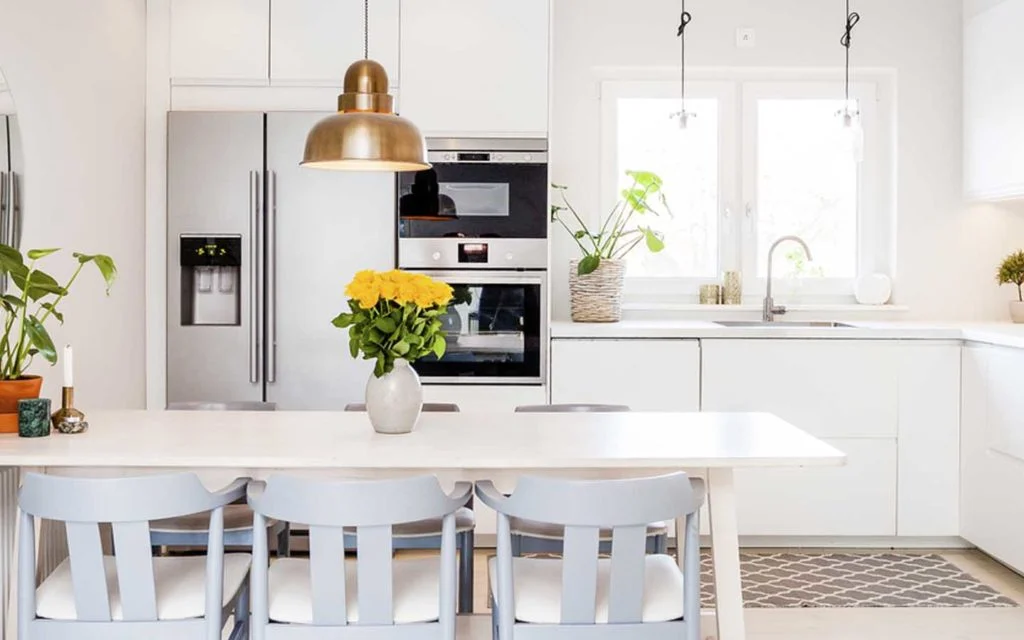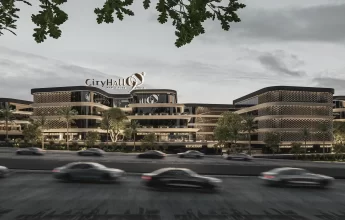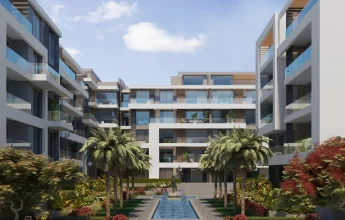Choosing The Perfect Kitchen Type For A Stylish Home

The Perfect Kitchen
When you choose a new kitchen for your home, you’re making a decision that affects your home appearance and your daily routines. You might find yourself quite distracted by the many kitchen types, styles, and materials available. In this article, you will learn about the most popular kitchen design styles, the dominant materials used in manufacturing, and their pros and cons.
To kick it off, it’s important to understand the main popular kitchen types and design styles today:
Modern Kitchen Style
The main thing of the modern kitchen types style is its focus on simple design, as it prioritizes the functionality of cooking over appearance. Most times, modern kitchens use straight, clean lines and open spaces. The most common colors in this design style are neutral tones like white, black, gray, and dark white. However, you can add up bold or bright colors to give the design a vivacious touch.
The furniture in this style is simple and practical and it eliminates the hassle of many decorations or complexity. Also, it relies heavily on natural lighting to create a sense of space and comfort.
Another advantage of this design is that it doesn’t depend on one material only; like other kitchen types, since you can choose from various materials according to your preference and needs, such as glass, metal, or engineered wood. Modern designs stress functionality, so kitchens are designed to be practical and efficient.In addition, the horizontal and vertical lines appear so clearly in cabinet layouts and work surfaces.
Classic Kitchen Style
The classic kitchen design exposes the traditional style of old designs for its roots are in the grand European homes such as English estates, French villas, or Tuscan homes from the 19th century. It is known for its elegant touches like carved engravings, ornate columns, and decorated cabinet edges.
The colors of classic kitchen types are usually warm and pleasant to look at, such as dark wood tones or neutral and calm paint colors like white and gray. Furthermore, the furniture is often made from natural materials such as marble and granite for countertops, while the floors are typically manufactured from wood or stone.
The designs of Classic kitchens can greatly differ as they can be customized differently. They incorporate simplicity in design with decorative details. Also, Classic cabinets are simple and minimalist, but there is no mistake with subtle details that add extra beauty. Colors play a major role in determining the overall vibes of the kitchen.
Now, let’s look at some common kitchen types and the materials used in their construction:
Cladding Kitchens
It is one of the kitchen types where its panels are made from aluminum coated with high protectant and durable materials. These panels are of high quality and ability to bear up against heat and moisture, thereby they are ideal for kitchen types full of steam and high temperatures from cooking and ovens thanks to their structure of 3 layers that provide strength and insulation.
Cladding panels are considered a great choice for many kitchen types as it is coated with fire-resistant and color-resistant layers, such as PVDF and Nano PVDF paint. That’s why, cladding is a wise option for kitchens in restaurants and hotels, as it helps maintain cleanliness and hygiene, being easy to clean and use in environments requiring a high level of sanitation.
Advantages of Cladding Kitchens:
- Cladding kitchens are highly resistant to moisture, heat, and even fire due to their coating with insulating materials like PVDF and Nano PVDF paint.
- The smooth surface of cladding panels makes them wash-friendly and prevents dirt and stains from accumulating. Its hygienic surface also eliminates the spread of germs and bacteria in the kitchen.
- Cladding is made from durable materials like aluminum and coated with additional layers that strengthen its resistance to damage, such as corrosion and scratches.
Disadvantages of Cladding Kitchens:
- If low-quality materials are used to coat cladding kitchens, they may become burnable and less resistant to moisture, heat, and wind.
- Cladding kitchens are most probably more expensive than other kitchen types.
- If one of the cladding layers is hit by any damage, you may endure much expense and effort to repair it, even completely replace the damaged section.
Aluminium Kitchen Types
Aluminum kitchens are amongst the most practical, comfortable, and stylish. They are first and foremost made from highly resistant treated aluminum panels, that’s why they are immune from heat and humidity. This type of kitchen turned up in Malaysia in 2008 but became popular so quickly.
The coating used on the aluminum sheets is a significant factor contributing to its quality. Important coatings comprise powder coating, anodized aluminum, and special paints for aluminum.
Advantages of Aluminium Kitchens:
- Aluminium stands firm against high temperatures and moisture so it is very common in kitchen use.
- You can swab aluminium kitchens effortlessly to draw out dirt and dust since it has a smooth surface.
- As Aluminium kitchens are strong and durable, it is easy to change their cabinet location.
- Aluminum kitchens have multiple shapes and colors to fit into various kitchen styles and decor.
- They can handle heavy use, being kept in good condition for a long time.
Disadvantages of Aluminium Kitchens:
- Aluminum kitchen prices are relatively more expensive when compared to other materials like wood or MDF.
- If not taken care of, The surface of aluminum can scratch easily.
Wooden Kitchens
Wooden kitchens are often the first thing that pops up in your mind when thinking of classic kitchens. Their characteristics include a high degree of durability with a beauty flair taken from nature. Wooden kitchens can be manufactured through many wood types. These types include hardwoods such as mahogany and oak, as well as plywood and compressed wood. The choice of wood depends on factors like budget, desired appearance, and durability.
Advantages of Wooden Kitchen types:
- Wooden kitchens fill your cuisine area with enchanting for those seeking a classic look.
- Natural woods provide distinctive colors; for example, mahogany has a rich red hue, while oak has a natural shine and strength.
- Wooden kitchens can be flexibly designed as there are many options to choose from, and you can incorporate other materials within each such as stone and glass.
- Wooden kitchens effectively insulate against heat and sound for more kitchen comfortable and private kitchen.
Disadvantages of Wooden Kitchens:
- If your kitchen is constantly exposed to moisture, especially near sinks or stoves, its appearance and function can be negatively affected over time.
- Wooden kitchens need high expense, particularly those made from natural wood like oak. Moreover, installation requires skilled craftsmanship.
- Wood is Susceptible to Scratches and may need periodic refinishing to maintain its shine.
- Hot pots and pans can scorch wooden surfaces. Also wood absorbs liquids easily, which may lead to fostering bacteria if not cleaned properly.
Polylac Kitchen types
Polylac is a synthetic material made from paper, processed with special chemicals, and pressed under high heat. Going through this process produces solid panels with a smooth surface that resists scratches and stains. As such it has become popular in furniture and kitchen design.
Advantages of Polylac Kitchens:
- Polylac comes as one of the most trendy kitchen styles plus it boosts various colors and finishes.
- It’s practical because it resists stains and scratches.
- Its cleaning is hassle-free with water and soap.
- Its installation and handling are super easy because of its lightweight.
Disadvantages of Polylac Kitchens:
- It lacks the smooth and natural look of wood.
- It may expand or shrink as a result of temperature changes, so it’s important to leave space between panels.
- Severe scraping can lead to scratches that are hard to repair.
- Long exposure to sunlight can cause the color to fade out or even change.
Acrylic Kitchens
Acrylic consists of a solid plastic material that can be transparent or colored, studied to be durable and resistant to scratches and stains. It’s used widely in furniture and furnishings, especially for kitchen surfaces. Acrylic kitchens are made by using high-quality compressed or particle wood as a base to provide strength and durability. And then this panel is covered with a thick, glossy layer of acrylic.
Advantages of Acrylic Kitchens:
- Acrylic kitchens are washing-friendly, and they fulfill your desire for a classy home with various colors, designs, and sizes.
- They can withstand high temperatures and humidity and don’t need special maintenance.
Disadvantages of Acrylic Kitchens:
- They can be scratched if heavy friction occurs.
- Acrylic kitchens can be a bit expensive.
- They may expand or shrink with temperature changes.
- They don’t offer a completely natural appearance.
Laminate Kitchens
Laminate is a fabricated multi-layered material, used frequently for making furniture, particularly kitchen countertops. The top layer consists of adorned paper covered with a protective resin that helps combat scratches and stains. This layer is glued to a base, mostly made of compressed or particle wood.
Advantages of Laminate Kitchens:
- The protective surface keeps it intact from scratches and stains.
- Laminate kitchens can be installed simply and quickly, which cuts back on installation costs.
- Laminate can hold out against moisture and moderate heat.
Disadvantages of Laminate Kitchens:
- It doesn’t have the natural warmth or look of real wood.
- It can suffer from deep scratches if sharp tools are used carelessly.
- Repairing laminate is complicated and usually needs a skilled worker.
Tips for Choosing from different Kitchen types for Your Home
Choosing the right kitchen takes up several important steps, such as your financial forecast, space size, preferred design style, and materials. To help you make the best choice, consider these ideas:
1- Initially set your budget since the larger budget will direct you to the more expensive options like natural wood or aluminum. If your budget is more limited, consider less costly materials like Polylac or acrylic.
2- Accurately measure the precise size of your kitchen and select a design that provides the beautiful look and practical movement you have ever wished.
3- Determine which materials will give you the desired style and adapt well to the use, movement, and space in your kitchen.
4- Visit kitchen exhibitions and ask for material samples of some of the kitchen types going through your mind.
5- Consult a kitchen design professional to guide you in selecting the best kitchen for your needs.
To Know More Details from concept properties click here through whatsapp or calling sales team 01200027090








